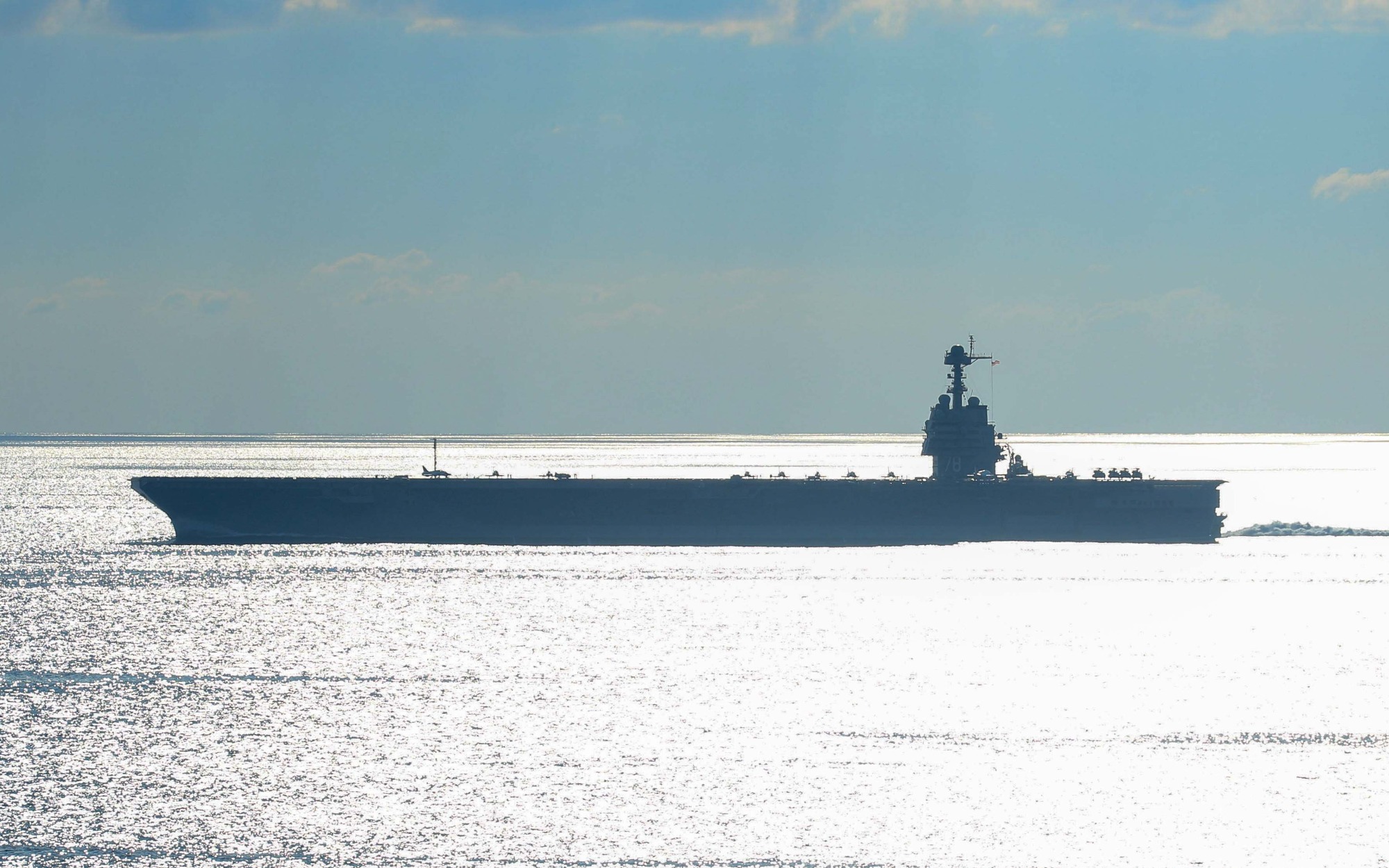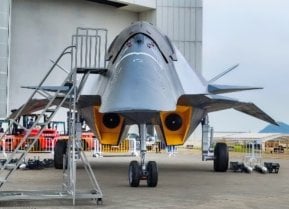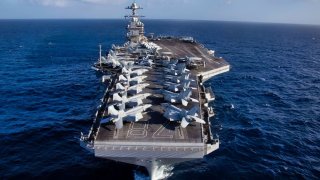Cancel the Ford-Class Aircraft Carrier Now
To continue building legacy systems, like the aircraft carrier, when our enemies have developed cheaper ways of negating the efficacy of carriers in modern combat, is not just decadent. It’s irresponsible. And it could lead to the United States losing a war.
What You Need to Know: The U.S. Navy's reliance on aircraft carriers, including the costly and technologically ambitious Ford-class carriers, faces growing scrutiny in an era of evolving threats like China's advanced anti-access/area denial (A2/AD) systems.

-While carriers remain symbols of American maritime dominance, their vulnerabilities to cheaper and more agile missile systems make them increasingly risky investments. Critics argue the Navy should shift funding toward submarines, unmanned vehicles, hypersonic weapons, and directed-energy systems to address modern challenges.
-Continuing to prioritize carriers over these advanced technologies risks rendering the U.S. Navy unprepared for future conflicts and wasting valuable resources.
The Ford-Class Dilemma: A Billion-Dollar Target for Modern Adversaries
The United States Navy just can’t quit its love affair with the aircraft carrier.
Since the Second World War, flat tops have been the center of the US Navy’s surface fleet. The primary projector of American maritime power, a fleet without the newest, largest, and most sophisticated floating airbases would not be the same.
Of course, these aircraft carrier arguments are eerily similar to the ones made by proponents of battleships 80 years ago.
Back then, it was the battleship that was the centerpiece of US Navy power projection and the aircraft carriers that were viewed as strange ancillary elements in the fleet.
That quickly changed after Japan’s surprise attack at Pearl Harbor in the Second World War.

Today, the Navy (and its supporters in Congress) operates as though it is still 1999. There are no real challenges to American military dominance. Carriers can come-and-go as they please anywhere on the face of the planet. All the locals can do is to stand in awe of America’s might when the flat tops show up to start imposing America’s will on the foreign shores they are deployed to.
The Enemy Gets a Vote on Aircraft Carriers
But America’s enemies have other plans.
Leading this charge against America’s continued global dominance is none other than the People’s Republic of China (PRC). While China has built its own rudimentary carrier force, Beijing has been more interested in depriving the Americans of their number one naval power projection platform: the aircraft carrier. China plans to do this, thanks to their robust arsenal of anti-aircraft/area denial (A2/AD) systems that can basically sink—or seriously damage—an aircraft carrier at the onset of any conflict between China and the United States.
And these A2/AD systems are infinitely cheaper and easier to replace than an American aircraft carrier. That is one reason that China, Russia, Iran, and North Korea have all invested vast sums into their respective A2/AD capabilities. The cost imbalance creates a strategic imbalance that likely favors the Chinese, Russian, North Korean, and Iranian militaries if it ever came to a showdown between their A2/AD capabilities and American flat tops.
What’s the Point of the Ford-class Aircraft Carrier?
The Ford-class aircraft carrier is the next-generation aircraft carrier that the Navy is (slowly) building. It is intended to replace the existing fleet of 11 Nimitz-class nuclear-powered aircraft carriers. Thus far, the Navy has deployed the first of this class in 2021—the USS Gerald R. Ford—and the next unit, USS John F. Kennedy (CVN-79) is set for deployment in 2025. After that, in 2028, will come the USS Enterprise (CVN-80). Lastly, the USS Doris Miller (CVN-81) is set for deployment in 2032.

The USS Gerald R. Ford cost $13 billion and took more than a decade to get out of the shipyard. A year after it was deployed, in 2022, it was still enduring technical issues. The follow-on carriers in this class are expected to be cheaper. But the fact remains that the carriers are hugely expensive, take a very long time to build, and are basically so complex and expensive that they are irreplaceable.
Since the funds have already been allocated for these warships, it will be difficult to cancel these systems. But future systems can absolutely be terminated. Especially if the United States military has not made developed any meaningful counter-A2/AD system—or anti-hypersonic weapon system—for these carriers.
We are building big, beautiful targets against which China’s advanced rocket forces can practice with live fire. If even one of these ships is sunk or its flight deck is significantly damaged, it would become the equivalent of a strategic wasting asset.
The Ford-class Aircraft Carrier: Decadence on Display
Diverting the funds and resources from any future Ford-class carrier after 2028 will be helpful for the US Navy to prioritize. First, it will need more Virginia-class attack submarines. Second, it will need to develop arsenals of sophisticated underwater unmanned vehicles (UUV) as well as advanced unmanned aerial vehicles (UAV). Third, the Navy needs to invest in its own hypersonic weapons capacity. Fourth, Navy resources need to be put into directed-energy weapons (DEW).
All these other expenditures, such as trying to replace the 10 Nimitz-class carriers with 10 Ford-class carriers when the Nimitz-class still has decades of service left, is one such example of wastefulness on the part of the Navy. It is the hallmark of a decadent country in decline that it has failed to adapt with the changing times.
We are living in an era where interest payments on the national debt will soon outstrip the nearly $1 trillion US defense budget. To continue building legacy systems, like the aircraft carrier, when our enemies have developed cheaper ways of negating the efficacy of carriers in modern combat, is not just decadent. It’s irresponsible. And it could lead to the United States losing a war.
Cancel the Ford-class aircraft carrier now.
Author Experience and Expertise: Brandon J. Weichert
Brandon J. Weichert, a National Interest national security analyst, is a former Congressional staffer and geopolitical analyst who is a contributor at The Washington Times, the Asia Times, and The-Pipeline. He is the author of Winning Space: How America Remains a Superpower, Biohacked: China’s Race to Control Life, and The Shadow War: Iran’s Quest for Supremacy. His next book, A Disaster of Our Own Making: How the West Lost Ukraine, is due October 22 from Encounter Books. Weichert can be followed via Twitter @WeTheBrandon.
All images are Creative Commons or Shutterstock.
From the Vault
Russia Freaked Out: Why the U.S. Navy 'Unretired' the Iowa-Class Battleships
Battleship vs. Battlecruiser: Iowa-Class vs. Russia's Kirov-Class (Who Wins?)


